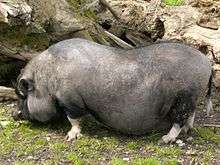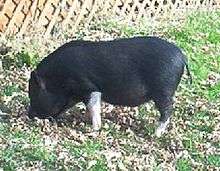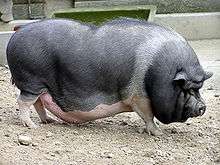Pot-bellied pig
 Two pot-bellied pigs sleeping | |
| Country of origin | Vietnam |
|---|---|
| Traits | |
|
Pig Sus scrofa domesticus | |
The pot-bellied pig (Vietnamese: lợn ỉ) is a breed of domesticated pig originating in Vietnam.
Description



Considerably smaller than standard American or European farm pigs, they weigh 43 to 136 kg (100 to 300 lb).
Boars, intact male pigs, become fertile at six months of age, long before they are completely physically mature. Pot-bellied pigs are considered fully grown by six years of age, when the epiphyseal plates in the long bones of the legs finally close.
Because pot-bellied pigs are the same species as ordinary farmyard pigs and descended from wild boars, they are capable of interbreeding. Most pot-bellied pigs have been crossed with various farm pig breeds. A 2004 study by them revealed extreme genetic diversity in indigenous Vietnamese pot-bellied pigs. They were also genetically different from each other according to location of origin in Vietnam. Pig breeds from developed countries were refined over centuries to a specific genetic make-up.[1] This means a cross between a purebred Vietnamese pot-bellied and another pig type, its genetic material is more diverse and the offspring will resemble the more specific pig imports. The German Agriculture Ministry has been assisting Vietnam with its pork production by introducing large breeds of pigs into Vietnam since the mid-1980's.[2]
Indigenous populations
Today, the Vietnamese and German governments have realized that the indigenous Vietnamese pig breed[3] exist only in mountainous Vietnam and Thailand. The Vietnamese government has begun to subsidize local farmers who continue to raise the indigenous pot-bellied pigs because it realizes they are neither as prolific nor as large as other breeds.[2]
Health
Many breeders recommend the spaying or neutering of both sexes at a young age if the owner does not wish to breed them.[4] Many local laws also require licensed pet pigs to be neutered.[5] The procedure is different from the method used in farm pigs.[6][7] Neutering is said to reduce the aggression of boars and female pigs during estrus, as well as the risk of testicular cancer and uterine tumors.[8] The hooves and tusks are also recommended to be trimmed.[9]
Abandonment
Pot-bellied pigs have been abandoned when owners discover that these pigs actually grow to larger sizes and require more care than they believed.[10][11][12] Others are forced to give up pet pigs due to local ordinances.[13][14]
According to Adam Goldfarb, the director of the Pets At Risk program for the Humane Society of the United States, "Pot-bellied pigs are really emblematic of what happens to an animal when it becomes a popular or fad pet. We saw this in the '90s when there was the initial pot-bellied pig craze. A lot of people went to buy them because they are so cute when they are little, but then they get big."[15]
Pot-bellied pig associations recommend adoption from local shelters instead of buying. Others like the Southern California Association for Miniature Pot-bellied Pigs and the California Pot-bellied Pig Association are actively involved in housing abandoned pet pigs.[16] Despite this, shelters often have difficulty in finding new homes for abandoned pigs.[14]
See also
- Domestic pig
- Ironwood Pig Sanctuary (a nonprofit pot-bellied pig sanctuary located in Pinal County, Arizona)
- Kunekune
- Miniature pig
References
- ↑ They, N.T.D. 2004. Genetic diversity and distances of Vietnamese and European pig breeds analysed with Microsatellite loci. Dissertation. Shaker g. Aachen, Germany.
- 1 2 Huyen, Le Thi Thanh; Roessler, Regina; Lemke, Ute; Zárate, Anne Valle (2005). Impact of the use of exotic compared to local pig breeds on socio-economic development and biodiversity in Vietnam (PDF). Beuren, Stuttgart: University of Hohenheim, Institute of Animal Production in the Tropics and Subtropics; Verlag Ulrich E. Grauer;F. u. T. Müllerbader GmbH. ISBN 3-86186-496-7. Retrieved February 23, 2011.
- ↑ http://www.dummies.com/education/science/smaller-than-species-subspecies-races-and-breeds/
- ↑ "Should Have My Pig Spayed Or Neutered?". The North American Potbellied Pig Association. 2009. Retrieved 16 January 2011. External link in
|publisher=(help) - ↑ "Ordinance Detail". PetPigZone. Retrieved April 17, 2011.
- ↑ Laurie J. Gage (2002). Hand-rearing wild and domestic mammals. Wiley-Blackwell. p. 33. ISBN 978-0-8138-2683-7.
- ↑ "Pot Bellied Pig Spay". Long Beach Animal Hospital. Retrieved April 17, 2011.
- ↑ Grenville Owen. "Neutered Pigs Make Better Pets". Pigrest. Retrieved April 17, 2011.
- ↑ Chris Christensen. "General Care". California Potbellied Pig Association, Inc. Retrieved April 17, 2011.
- ↑ Lianne Mcleod. "Pot Bellied Pigs as Pets: What to Expect from a Pet Pig". About.com. Retrieved April 17, 2011.
- ↑ Grenville Owen. "Not so Micro". Pigrest. Retrieved April 17, 2011.
- ↑ "Basic Information". The Menagerie. Retrieved April 17, 2011.
- ↑ Gerry (March 6, 2009). "Pot-bellied pig case sparks local scrutiny". Valley News. Retrieved April 17, 2011.
- 1 2 Gerry Hogan. "Pigs Need Love Too!". Connections for Women. Retrieved April 17, 2011.
- ↑ Sallie James. "Two potbellied pigs living large in Coral Springs". Miami Herald. Retrieved April 17, 2011.
- ↑ "Pot Bellied Pig Adoption Links". PigHarmony.com. Retrieved April 17, 2011.